Norvic Philatelics - GB New Stamps and Special Postmarks
Pictorial Faststamps: Freshwater Life - Ponds - 22 February 2013
In 2013 the Post & Go pictorial
Faststamps series will be on Freshwater Life. Freshwater
covers just one per cent of the Earth’s surface, yet ten per cent of the
world’s creatures live in this environment.
Half of the United Kingdom's ponds have been lost in the twentieth century.
The series will feature some of the fish, amphibians and invertebrates that
live in the UK’s ponds, lakes and rivers over a set of three issues. ‘Ponds’
is the first issue in the series, followed by ‘Lakes’ (20 June) and then
‘Rivers’ (20 September).
There will be three sets of stamps in the year. The first looking at Life in
Ponds. The second in the year will look at larger freshwater bodies such as
lakes. Finally the third issue will explore the life of rivers and
streams. Post & Go terminals allow customers to weigh their
letters and packets, pay for and print postage labels and stamps without the
need to visit the counter. The first Post & Go machine was trialled in
The Galleries Post Office® in Bristol in 2008. The labels will be used
in Post & Go machines at Post Offices around the country, and from the
Hytech machines at Spring Stampex.
The labels can be obtained with 6 different service indicators: 1st class up
to 100g & 1st class Large up to 100g, Europe up to 20g, Worldwide up to
10g and 20g, and the new Worldwide 40g. The stamps are dispensed
singly or in strips of up to 5 of the same value or various values. Thus
there are 36 different value/design combinations in total.

Row 1: Lesser Silver Water Beetle, Three-spined Stickleback,
Smooth Newt;
Row 2: Fairy Shrimp, Emperor Dragonfly, Glutinous Snail
|
The stamps in detail
Lesser Silver Water Beetle
About 15mm long, the Lesser Silver Water Beetle, Hydrochara
Caraboides, is a species of water scavenger beetle. Although the
beetle is actually black, hairs on the underside of its body trap a silvery
looking air bubble that enables the beetle to breathe underwater, giving the
beetle its name. Eggs are laid in spring or early summer, and the larvae are
often found from May to July, floating just below the surface. Adults are
herbivores and feed on decaying plant matter, but the larvae are carnivores,
and feed on water snails. In the UK it is found only in the Somerset Levels,
Cheshire and North-East Wales. It is classified as an endangered species
protected under the Wildlife and Countryside Act 1981.
Three-Spined Stickleback
Gasterosteus aculeatus is the larger of our two sticklebacks. It is
usually 5cm long (but may reach, exceptionally, twice that length). In front
of the dorsal fin there are the three spines that give the fish its name
(though some individuals may have two or four). Along with the pelvic and
anal spines these can be locked erect, making the fish extremely hard to
swallow by a predator. The Stickleback can live in fresh, brackish or salt
water and is found in ditches, ponds, lakes, backwaters, quiet rivers,
sheltered bays, marshes, and harbours.
Smooth Newt
Also known as the Common Newt, Lissotriton Vulgaris is found
throughout Europe except the far north, areas of Southern France and the
Iberian peninsula. Females and non-breeding males are pale brown or olive
green, often with two darker stripes on the back. Both sexes have an orange
belly, although in females, it is paler. This is covered in rounded black
spots. They have a pale throat with conspicuous spots. During the breeding
season, males develop a continuous wavy crest that runs from their head to
their tail, and their spotted markings become more apparent. They are also
distinguishable from females by their fringed toes. Like other amphibians
their eggs are laid in the water and hatch into tadpoles, which eventually
develop into air breathing adults.
Fairy Shrimp
Chirocephalus diaphanous, is a beautiful, translucent crustacean,
which lacks a carapace. It has a relatively large number of segments and
bears 11 pairs of legs, fringed with bristles; the head curves downwards,
and in males, the second pair of antennae are modified ‘claspers’ for
grabbing females during mating. Fairy Shrimps swim around on their backs,
propelled by constantly moving legs. They hatch during the cooler parts of
the year, as water returns to their shallow ponds, which dried out during
the summer. They reach maturity over winter, then lay eggs, which can
survive long periods of drought and then die when their ponds dry out in
spring. It is found in no more than 100 ponds in the whole of the UK. Fairy
Shrimps are protected by the Wildlife and Countryside Act and can be found
in Hampshire’s New Forest, on the edge of Dartmoor in Devon, on Salisbury
Plain, in parts of the Sussex Weald, as well as in Oxfordshire, East Anglia
and South Wales.
Emperor Dragonfly
Anax Imperator, is a large and powerful species of hawker dragonfly
averaging 78mm in length. It is found in Europe, Africa and Asia. Males have
a sky blue abdomen with a black dorsal stripe and an apple green thorax.
Females have a green thorax and abdomen. The species live by ponds, gravel
pits, and slow rivers, where they feed on other insects and tadpoles. Eggs
are laid on pondweed and the larvae develop underwater as ferocious
predators, feeding on invertebrates, tadpoles and even small fish.
Glutinous Snail
Myxas Glutinosa, is a small air-breathing freshwater snail. This
snail is unusual in that it extends its almost transparent mantle to
completely cover the shell when moving, giving the animal a glass-like
appearance. It also makes the animal sticky to the touch, hence its common
name. It is only found in very clear, clean ponds, lakes and canals. This
species has undergone a big decline, and while it was once found throughout
the UK, it is now known from only one site in Wales. As a result it is
classified as endangered in the UK and protected under the Wildlife and
Countryside Act 1981. The reasons for its decline are almost certainly due
to water pollution particularly from nutrient enrichment.
Technical details:
Designed by Kate Stephens and illustrated by Chris Wormell the six 56mm x
25mm stamps are printed in gravure by Walsall Security Printers, with two
phosphor bars. The stamps in the pack will have the service indicator
and other detail printed in gravure. All images are by kind
permission of Royal Mail, Copyright 2013. This website is copyright Norvic
Philatelics 2013.
Products issued
The labels will be used in Post & Go machines at Post Offices around
the country, and from the Hytech machines at Spring Stampex.
A mint set of 6 x 1st will also be available from Royal Mail's Tallents
House Bureau in a pack similar to a presentation pack. All values in
the pack are 1st Class with a philatelic branch code.
Royal Mail will again produce a First Day Cover and official First Day
Postmarks for these.
Special Postmarks
Postmarks available for the day of issue will be shown here These are
not to scale. These postmarks cannot be obtained after the date
of issue.

|
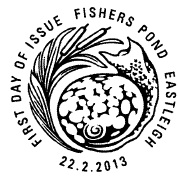
|
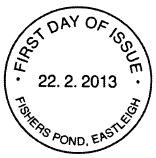
|
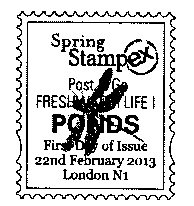
|
Ref FD1306TH
Philatelic Bureau Official Postmark illustrated with a map of the
British Isles |
Ref FD1306PL
Fishers Pond, Eastleigh
|
Ref FD1306NP
Fishers Pond, Eastleigh |
Ref L12798 *
Autumn Stampex Post & Go Pond Life London N1
|

|
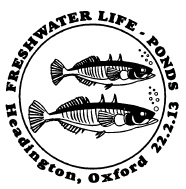 |
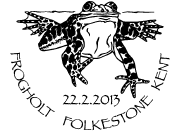
|
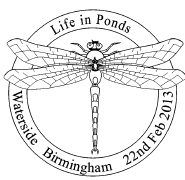
|
Ref L12785 Potter Heigham, Norfolk.
|
Ref L12786
Headington, Oxford |
Ref L12787
Frogholt, Folkestone, Kent
|
Ref M12789
Waterside, Birmingham
|
* The standard Stampex postmark (Ref L12797) is also available
on this day. |
This page updated 12 February 2013
If you wish to be told when this page is updated, please use the
ChangeDetection box at the top of this page.
If you have any questions, please email
us.
NB: all emails will be acknowledged in 1-2 days
unless we are away (see home page). If you do not receive an
acknowledgement please email us from a different address (eg hotmail,
gmail).
Instant
Printing Prices from Webmart
Instant
Printing Prices from Webmart








